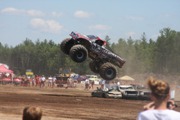I’m going to start this column off with an admission. I was utterly impressed with monster trucks last weekend. No fake impressed, but really, honestly, holy f’n crap impressed watching a group of monster trucks go at it at New England Dragway during their All Wheel Jamboree. Laugh if you want, but seeing trucks that weigh in at five or so tons launch to heights that exceed the roof line of my house and land with no problem really blew me away.
It had been a while since I had seen modern monster trucks and despite the cartoonish setting that they compete in on television, they are marvels of engineering and mechanical evolution. It was not that many years ago that the trucks were using steel bodies and riding around on leaf spring packs that were so stiff the axles may as well have been welded straight to the frame.
The trucks had an interesting effect on my son Tom and I believe it happened because we were watching them at ground level and at close proximity. We were not in an arena, up in the stands. We were standing right there, watching them wreck everything in their path. Basically, the trucks scared the crap out of my son. He hung in there for most of the show, but the last truck (which had the most talented and balls out driver) flipped his fear switch and he told me he was scared. He still digs watching them on TV but it is going to be a while before he gets back to a live show I think. I was legitimately fascinated by how fast, agile, and indestructible they seemed to be.
—
Turbochargers are now a full fledged part of modern hot rodding. They’ve always been there, lurking on the fringes and shadows, but now it is a full on revolution. Back in the early 1960s the Malllicoat brothers won B-Gas Supercharged at the NHRA Winternationals with a twin turbo small block Chevy. They used Carter carbs in a draw through design with twin Garrett turbos. That’s proof enough of the history turbochargers have in the traditional American hot rodding realm.
Turbos are also the lightning rod du jour in hot rodding as well. One camp claims that they are expensive, complicated, and not accessible to the average hot rodder. On the other side of the argument are the guys saying that with the right amount of chutzpah, smart shopping, and DIY inventiveness, you can make stupid power in a more forgiving and gentle manner than other power adding options offer.
I find myself standing right in the middle because I’m reasonably sure that both sides are too eager to plead their case in a dramatic fashion. It ain’t as tough as the haters make it out to be and it ain’t as cheap as the proponents make it out to be.
That being said, I’ve been lucky enough to drive several cars and trucks that are force fed with turbochargers and it is an intoxicating experience. In my own personal education as a gearhead, I think a turbo project is a goal I need to have.
Each hot rod generation has it’s battle ground. In the early days it was flatheads versus overhead valve engines, then it became muscle cars versus hot rods, in the 1970s it was simply a fight for survival and now it is the battle of power adders.
I really don’t understand the hatred/anger side of the fight. There are plenty of logical dudes saying that a roots blower (or belt driven intake manifold…we love that) can perform at the same level in most normal applications without all the extra hassle that a turbo provides. For the most part they are right, but until you feel the hand of the horsepower god reach down and shoo you ahead like there’s a JATO rocket tied to your ass, the “feel” of turbo power won’t mean anything to you.
No matter what the naysayers blather about, the “cheap turbo” story in the September 2010 issue of Car Craft did LOTS for the average dude thinking about hair dryers on their motor. Doug Glad and company get the 100% BangShift approval for that story!
—
I’m actually saddened by the complete and utter failure of the “new” AHRA. I didn’t expect them to take over the world, but I was at least hoping that they would conduct a successful series at a set of tracks that would benefit from some decent exposure.
To this point it seems that they have succeeded in taking money from people for membership and race entry fees and little else. Their issues began in earnest when they announced that they wanted to sanction race tracks. This gave the NHRA a perfect excuse to disallow them from holding events on tracks that they sanctioned.
They countered by sanctioning several tracks that did not have deals with NHRA or IHRA. After the complete calamity that this season has become, the tracks that they “sanction” will probably be throwing them out on their behinds when the contract is up.
This whole thing is scarily reminiscent of the ADRA scandal of the early 2000s. ADRA was a sanctioning body that sprung up to promote nostalgia drag racing. It too folded after just a couple of races, the leader of the scan, Bill Chapman running off with the remaining cash. The only good that came from the ADRA nightmare was the fact that it really kicked the nostalgia funny car movement into gear. The AHRA has just harmed several race tracks in the US and Canada and ruined the faith that a bunch of people had in the revival of an iconic name in drag racing.
—-
Thanks for reading,
Brian
























